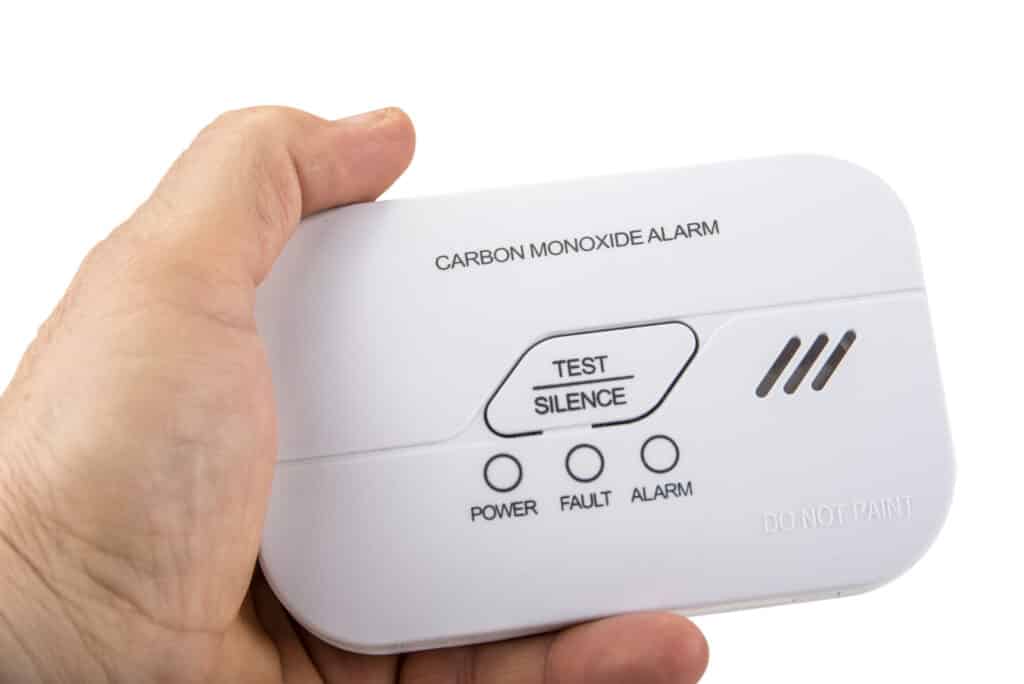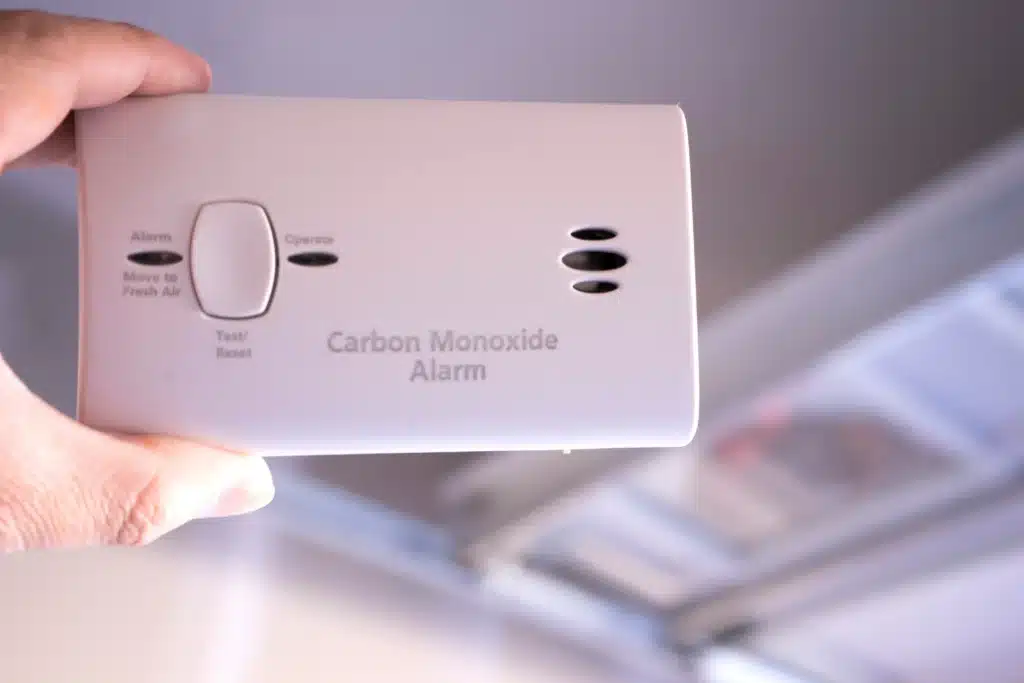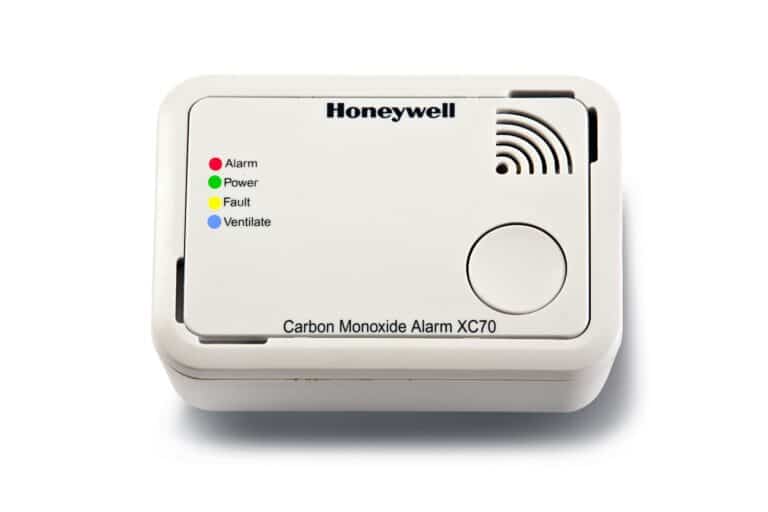Introduction
Where To Put A Carbon Monoxide Detector: Ensuring the safety of your home and the well-being of your loved ones is a top priority. One crucial step in achieving this is properly placing a carbon monoxide (CO) detector within your living space. Carbon monoxide is a colorless, odorless, and tasteless gas that can be emitted by common household appliances and sources, such as gas furnaces, stoves, fireplaces, and even vehicles left running in an attached garage. Because of its undetectable nature, a CO leak can go unnoticed, potentially leading to serious health risks or even fatalities.
Among these threats, carbon monoxide (CO) poses a particularly insidious danger due to its elusive qualities. As an odorless, colorless, and tasteless gas, CO can quickly accumulate to hazardous levels without any visible signs. It originates from common household sources like heating systems, water heaters, gas stoves, and even wood-burning fireplaces. Inadequate ventilation or faulty appliances can lead to the gradual buildup of this toxic gas, putting occupants at risk of CO poisoning.
This colorless, odorless gas can emanate from everyday appliances such as furnaces, water heaters, and gas stoves, silently infiltrating your living space without any noticeable warning signs. The consequences of CO exposure can be severe, ranging from headaches and dizziness to unconsciousness and even death. To shield your loved ones from this hidden menace, the strategic placement of carbon monoxide detectors is a non-negotiable imperative.

What is best location for carbon monoxide detector?
Where should you place a carbon monoxide detector?
- Outside of each bedroom or sleeping area.
- Inside an attached garage.
- On every floor, including the basement.
- At least 10 feet from the garage door leading to your home.
- At least 15 feet away from gas-burning appliances, like fireplaces or stoves.
Placing a carbon monoxide detector near sleeping areas, such as in hallways outside bedrooms, is crucial. During sleep, individuals are less likely to notice the initial symptoms of CO exposure. Which can lead to delayed reactions and worsened health effects. By situating a detector in close proximity to where people sleep, you increase the chances of receiving an early warning that prompts quick action.
Carbon monoxide can accumulate in various areas of a home, especially if there are multiple sources of combustion. To cover all potential risk areas, it’s recommended to install detectors on every floor of your home, including the basement. This approach ensures that no matter where the CO originates, a detector is nearby to alert you.
Fuel-burning appliances such as furnaces, water heaters, and gas stoves are common sources of carbon monoxide. Placing a detector in the same room as these appliances provides immediate detection if a malfunction or leak occurs. For optimal effectiveness, the detector should be located at least 5 feet away from these sources to avoid false alarms caused by normal emissions during operation.
CO detectors should not be placed in dead air spaces where air circulation is limited. Such as corners of rooms or behind curtains. These areas might not receive sufficient airflow to detect CO in a timely manner. Instead, opt for locations with good air circulation to ensure that the gas reaches the detector.
Does carbon monoxide make you sleepy?
Most people with a mild exposure to carbon monoxide experience headaches, fatigue, and nausea. Unfortunately, the symptoms are easily overlooked because they are often flu-like. Medium exposure can cause you to experience a throbbing headache, drowsiness, disorientation, and an accelerated heart rate.
Carbon monoxide (CO) is a colorless, odorless, and tasteless gas that can pose serious health risks when inhaled at high concentrations. One common question that arises about carbon monoxide exposure is whether it can make you sleepy. The answer is both straightforward and complex. As understanding the effects of CO on the body requires delving into its impact on oxygen transport and overall health.
Carbon monoxide binds to hemoglobin in red blood cells more readily than oxygen does. Hemoglobin is responsible for carrying oxygen from the lungs to the body’s tissues and organs. When CO binds to hemoglobin, it forms carboxyhemoglobin, reducing the blood’s ability to carry oxygen effectively. This process results in decreased oxygen delivery to vital organs, including the brain.
While carbon monoxide itself doesn’t induce sleepiness directly. The reduced oxygen supply to the brain and body can lead to a range of symptoms, including fatigue, drowsiness, and confusion. As the oxygen levels in the bloodstream drop, the brain’s function becomes compromised. This can result in feelings of lethargy, difficulty concentrating, and ultimately, an overwhelming desire to sleep.
Carbon monoxide poisoning can be life-threatening if not addressed promptly. In severe cases, individuals may lose consciousness. Slip into a coma, or experience organ failure due to the lack of oxygen. Long-term exposure to low levels of carbon monoxide can also result in chronic health issues. Including cognitive impairments and cardiovascular problems.
Can you smell carbon monoxide?
Carbon monoxide has no smell. It is an odorless, colorless gas that’s a byproduct of combustion. Because carbon monoxide can leak from your gas furnace, stove, dryer, water heater, wood stove or gas fireplace. It is essential to put safeguards in place for immediate detection when a leak occurs.
Carbon monoxide is produced as a byproduct of incomplete combustion. It is often emitted from fuel-burning appliances such as gas furnaces, water heaters, stoves, and vehicles. Unlike other gases that may have distinct odors. Such as natural gas (which often smells like rotten eggs due to the addition of a chemical called mercaptan), carbon monoxide does not have a naturally occurring odorant.
The reason carbon monoxide lacks a distinct odor is rooted in its molecular structure. The olfactory receptors in our noses detect odors based on specific chemical interactions with molecules. Carbon monoxide molecules are very small and lack the necessary functional groups that would trigger these receptors. As a result, even though carbon monoxide can be present in dangerous concentrations, our sense of smell cannot detect its presence.
Because carbon monoxide is odorless, individuals cannot rely on their sense of smell to alert them to its presence. This poses a significant threat, as exposure to even low levels of CO over an extended period can lead to serious health issues, including headaches, dizziness, confusion, nausea, and in severe cases, loss of consciousness and death.
To protect yourself and your loved ones from the dangers of carbon monoxide. It’s crucial to install carbon monoxide detectors in key locations within your home. These detectors are designed to sound an alarm when elevated CO levels are detected. Providing you with an early warning system that can save lives.
How quickly does carbon monoxide make you sick?
High concentrations of carbon monoxide kill in less than five minutes. At low concentrations it will require a longer period of time to affect the body. Exceeding the EPA concentration of 9 ppm for more than 8 hours is suspected to produce adverse health affects in persons at risk.
The speed at which carbon monoxide makes you sick depends on the concentration of the gas in the environment and the duration of exposure. In cases of acute exposure to high concentrations (such as from a malfunctioning gas furnace). Symptoms can appear within a few hours, and severe poisoning can lead to unconsciousness or death in a matter of minutes to hours.
Long-term exposure to lower concentrations of carbon monoxide can result in chronic health issues. This might include cognitive impairments, cardiovascular problems, and other conditions that can develop over weeks, months, or even years of exposure.
Certain individuals are more susceptible to the effects of carbon monoxide poisoning, particularly children. The elderly, pregnant women, and individuals with preexisting health conditions like heart disease or anemia. These populations might experience symptoms more quickly and at lower concentrations.
The timeline of carbon monoxide poisoning underscores the importance of taking swift action in the event of suspected exposure. If you or anyone in your household experiences symptoms like headaches, dizziness, nausea, or confusion, and these symptoms improve when you leave your home. It’s crucial to evacuate the premises immediately and seek medical attention. Opening windows and doors to ventilate the area can help disperse the gas while waiting for professional assistance.
How quickly can you feel carbon monoxide?
You may lose balance, vision and memory and even consciousness. This can happen within 2 hours if there’s a lot of carbon monoxide in the air. The smaller an animal or person is, the faster they’ll be affected. Pets are often the first to show symptoms.
The initial symptoms of carbon monoxide poisoning can appear relatively quickly, particularly when exposed to high concentrations of the gas. While carbon monoxide doesn’t have an immediate irritant effect that causes immediate discomfort. Its effects become apparent as it starts to interfere with the body’s oxygen transport mechanism.
Initial Symptoms: Symptoms such as headache, dizziness, nausea, and fatigue can begin to manifest within a few hours of exposure to elevated levels of carbon monoxide. These symptoms are often mistaken for other common ailments, which can delay the recognition of CO poisoning.
Acceleration of Symptoms: As exposure continues or if the concentration of CO is higher, symptoms can intensify rapidly. Individuals may experience confusion, difficulty concentrating, shortness of breath, and a sense of overall weakness.
Dangerous Levels: In cases of acute exposure to high concentrations of carbon monoxide, symptoms can escalate to loss of consciousness, seizures, and even death within a matter of minutes to hours. The speed of onset depends on factors such as the gas concentration and the individual’s overall health.
Chronic Exposure: Long-term exposure to lower concentrations of carbon monoxide can result in chronic health issues that develop over weeks, months, or years. These health problems might include cognitive impairments, cardiovascular complications, and other conditions that gradually worsen over time.
What are the six signs of carbon monoxide poisoning?
The most common symptoms of CO poisoning are headache, dizziness, weakness, nausea, vomiting, chest pain, and confusion. People who are sleeping or who have been drinking alcohol can die from CO poisoning before ever having symptoms.
A persistent and throbbing headache is one of the most common early symptoms of carbon monoxide poisoning. It can often be mistaken for other types of headaches or even migraines. If you notice a sudden and unexplained onset of a severe headache, especially when indoors. It’s important to consider the possibility of CO exposure.
Feeling dizzy, lightheaded, or nauseous can be indicative of carbon monoxide poisoning. These symptoms often occur together and can be exacerbated by physical activity. If you find yourself feeling unsteady or experiencing an upset stomach without an obvious cause, it’s wise to investigate potential sources of CO.
Exposure to carbon monoxide can lead to feelings of extreme fatigue and weakness. Individuals may feel unusually tired, even after restful sleep, and have difficulty summoning the energy to engage in normal daily activities.
Difficulty breathing or shortness of breath can be an alarming symptom of carbon monoxide poisoning. This sensation may worsen during physical exertion or when exposed to higher concentrations of the gas.
Mental confusion, difficulty concentrating, and impaired judgment can manifest as CO levels rise in the bloodstream. Individuals might find it challenging to process information, make decisions, or remember simple details.
Where does carbon monoxide poisoning start?
CO is found in fumes produced any time you burn fuel in cars or trucks, small engines, stoves, lanterns, grills, fireplaces, gas ranges, or furnaces. CO can build up indoors and poison people and animals who breathe it.
Fuel-Burning Appliances: Gas furnaces, water heaters, stoves, ovens, and fireplaces are potential sources of carbon monoxide if they malfunction, are improperly vented, or lack proper maintenance.
Vehicle Exhaust: Operating vehicles in enclosed spaces, such as garages or basements, or leaving them running for an extended period in attached garages can lead to the accumulation of carbon monoxide.
Generators and Heaters: Portable generators, space heaters, and other gas-powered equipment used indoors without proper ventilation can emit carbon monoxide.
Blocked Chimneys or Vents: Blocked chimneys, flues, or vents can prevent the proper escape of combustion gases, leading to a buildup of carbon monoxide indoors.
The symptoms of carbon monoxide poisoning can vary depending on the concentration of the gas and the duration of exposure. Early signs often resemble those of the flu and can include headaches, dizziness, nausea, fatigue, confusion, and shortness of breath. These symptoms can easily be mistaken for other common ailments, delaying the recognition of carbon monoxide poisoning.
Why is carbon monoxide a silent killer?
It is called the “silent killer” because it is colorless, odorless, tasteless and non- irritating. If the early signs of CO poisoning are ignored. A person may lose consciousness and be unable to escape the danger. More people die from carbon monoxide exposure than any other kind of poisoning.
One of the primary reasons carbon monoxide is dubbed a silent killer is its lack of detectable sensory characteristics. Unlike other dangerous gases, such as natural gas, which often has a distinct rotten egg odor due to added odorants, carbon monoxide is completely colorless, odorless, and tasteless. This means that individuals cannot rely on their senses to detect its presence, making it difficult to recognize without proper equipment.
The invisibility of carbon monoxide gas makes it challenging to identify its presence visually. There are no visible signs, changes in color, or haze that would indicate its existence in the air. This lack of visible cues can lead to a false sense of security, as individuals are unable to perceive any immediate threat.
Carbon monoxide’s deadly potential is amplified by its affinity for hemoglobin in red blood cells. When inhaled, CO quickly binds to hemoglobin, forming carboxyhemoglobin. This compound prevents oxygen from binding to hemoglobin, reducing the blood’s ability to carry and deliver oxygen to vital organs and tissues. As a result, even low levels of carbon monoxide can lead to tissue hypoxia, causing damage to organs and potentially leading to death.
The symptoms of carbon monoxide poisoning, especially at low levels of exposure, can be mistaken for other common ailments. Early signs such as headache, dizziness, nausea, and fatigue may not immediately be attributed to carbon monoxide exposure. This delay in recognizing the true source of the symptoms can allow the poisoning to progress unchecked.

Conclusion
In the pursuit of a secure and healthful home environment, the significance of proper carbon monoxide (CO) detector placement cannot be overstated. By strategically installing these vigilant devices throughout your living space, you create an essential layer of defense against the imperceptible threat of CO gas. The meticulous consideration of key factors such as proximity to potential sources, optimal height, and the number of detectors guarantees comprehensive coverage and early detection. As we conclude our exploration, remember that the well-being of your loved ones depends on your proactive approach to safety.
By taking the time to position carbon monoxide detectors thoughtfully, you are not only safeguarding against a hidden danger but also establishing a haven where security, comfort, and peace of mind prevail. By heeding the guidelines for optimal placement discussed in this guide, you are fortifying your home against a threat that can otherwise remain undetected until it’s too late. Remember, the well-being of your family hinges on your preparedness and attention to detail.
As you conclude this journey of understanding, rest assured that your commitment to strategically positioning carbon monoxide detectors is a resolute step towards ensuring the safety, health, and tranquility of those who matter most. The imperceptible nature of CO gas underscores the importance of proactive measures, and CO detectors stand as stalwart guardians against this silent threat. By adhering to the guidelines outlined in this guide – considering potential sources, optimal heights, and adequate coverage – you are actively enhancing the protection of your living space. Remember, the wellbeing of your household depends on your commitment to their safety. As you finalize your approach to CO detector placement, you are not only preventing potential harm but also cultivating an environment where peace of mind and security flourish.

